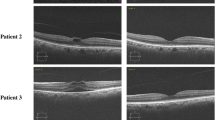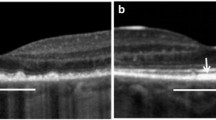Zusammenfassung
In der Behandlung subfovealer, okkulter und klassischer chorioidaler Neovaskularisationen im Rahmen der altersabhängigen Makuladegeneration hat sich bisher keine Therapie als wirksam erwiesen. Ein neuerer Therapieansatz ist die fraktionierte Teletherapie, wobei die bisherigen Ergebnisse von Studien kontrovers sind.
In einer prospektiven Studie führten wir bei 40 Patienten, davon 9 Männer und 31 Frauen, mit einem mittleren Alter von 74 Jahren mit feuchter AMD und Einbeziehung der Fovea eine Teletherapie durch. Acht Patienten hatten eine klassische subretinale Membran, 32 eine okkulte in der Fluoreszenzangiographie, davon 14 mit einer Pigmentepithelabhebung. Die Bestrahlung mit einer Gesamtdosis von 14,4 Gy erfolgte von einem lateralen Stehfeld mit einem Linearbeschleuniger (X-8) in acht Fraktionen mit 1.8 Gy Einzeldosis.
Der Visus war nach einem Jahr Nachbeobachtungszeit bei 6 Patienten unverändert, bei den restlichen 34 verschlechterte er sich um 2 oder mehr Optotypenreihen. Das zentrale Gesichtsfeld verschlechterte sich signifikant von 16,5 dB auf 12,4 dB. Fundoskopisch als auch angiographisch konnte bei keinem Patienten eine Regression oder Stabilisierung der chorioidalen Neovaskularisationen beobachtet werden.
Nach unseren Ergebnissen hat eine Teletherapie mit einer Gesamtdosis von 14,4 Gy in acht Fraktionen keinen Einfluß auf die Funktion und die exsudativen Netzhautveränderungen bei altersabhängiger Makuladegeneration.
Summary
Treatment of patients with neovascular agerelated macular degeneration (AMD) presenting with CNV which extend under the center of the fovea is discouraging. A new therapeutic regimen is the application of radiation, but the results of initial studies are contradictory.
In a prospective study 40 patients — 9 males and 31 females — with a mean age of 74 years and exudative AMD with involvement of the fovea were treated with radiation. Eight patients had classic, well-defined CNV, 32 had occult lesions. Radiation was administered on the posterior pole with a 8 MV-photon beam at a linear accelerator. A dose of 14.4 Gy, 1.8 Gy per day, 5 fractions per week was delivered through a single lateral port.
After a follow-up of one year the visual acuity was stable in 6 patients and deteriorated by two or more lines in 34 patients. The central visual fields decreased significantly from 16.5 dB to 12.4 dB. The neovascular changes progressed in all patients.
Our results did not show a beneficial effect of the radiation treatment with a dosage of 14.4 Gy whether on visual acuity nor on exudative changes in patients with AMD.
Similar content being viewed by others
Literatur
Bergink GJ, Deutman AF, van den Broek JFCM, van Daal WAJ, von der Maazen RWM (1994) Radiation therapy for subfoveal choroidal neovascular membranes in age-related macular degeneration: a pilot study. Graefe’s Arch Clin Exp Ophthalmol 232: 591–598
Bergink GJ, Deutman AF, van den Broek JFCM, van Daal WAJ, van der Maazen RWM (1995) Radiation therapy for age-related subfoveal choroidal neovascular membranes. Doc Ophthalmol 90: 67–74
Bressler NM, Frost LA, Bressler SB, Murphy RP, Fine SL (1988) Natural course of poorly defined choroidal neovascularisation associated with macular degeneration. Arch Ophthalmol 106: 1537–1542
Chakravarthy U, Houston RF, Archer DB (1993) Treatment of age-related subfoveal neovascular membranes by teletherapy: a pilot study. Br J Ophthalmol 77: 265–273
De Gowin RL, Lewis JL, Mueller AL, Gibson DP (1974) Radiosensitivity of human endothelial cells in culture. J Lab Clin Med 84: 42–48
Eissner G, Kohlhuber F, Grell M, Üffing M, Scheurich P, Hieke A, Multhoff G, Bornkamm GW, Holler E (1995) Critical involvement of transmembrane tumour necrosis factor-alpha in endothelial programmed cell death mediated by ionizing radiation and bacterial endotoxin. Blood 86: 4184–4193
Freund KB, Yannuzzi LA, Sorenson JA (1993) Age-related macular degeneration. Am J Ophthalmol 115: 786–791
Guyer DR, Fine SL, Maguire MG, Hawkins BS, Owens SL, Murphy RP (1986) Subfoveal choroidal neovascular membranes in age-related macular degeneration. Visual prognosis in eyes with relatively good initial visual acuity. Arch Ophthalmol 104: 702–705
Hosoi Y, Yamamoto M, Ono T, Sakamoto K (1993) Prostacyclin production in cultured endothelial cells is highly sensitive to low doses of ionizing radiation. Int J Radiat Biol 63: 631–638
Lopez PF, Grossniklaus HE, Lambert HM, Aaberg TM, Capone A, Sternberg P, L’Hernault N (1991) Pathologic features of surgically excised subretinal neovascular membranes in age-related macular degeneration. Am J Ophthalmol 112: 647–656
Macular Photocoagulation Study Group (1991) Argon laser photocoagulation of neovascular maculopathy. Arch Ophthalmol 109: 1109–1114
Macular Photocoagulation Study Group (1991) Laser photocoagulation of subfoveal neovascular lesions in age-related macular degeneration. Arch Ophthalmol 109: 1220–1231
Raicu M, Vral A, Thierens H, De Ridder L (1993) Radiation damage to endothelial cells in vitro, as judged by the micronucleus assay. Mutagenesis 8: 335–339
Rubin DB, Drab EA, Kang HJ, Baumann FE, Blazek ER (1996) WR-1065 and radioprotection of vascular endothelial cells. I. Cell proliferation, DNA synthesis and damage. Radiat Res 145: 210–216
Slakter JS, Yannuzzi LA, Sorenson JA, Guyer DR, Ho AC, Orlock DA (1984) A pilot study of indocyanine green videoangiography-guided laser photocoagulation of occult choroidal neovascularisation in age-related macular degeneration. Arch Ophthalmol 112: 465–472
Velikay M, Stolba U, Wedrich A, Datlinger P, Akramian J, Binder S (1994) The antiproliferative effect of fractionized radiation therapy: optimization of dosage. Doc Ophthalmol 87: 265–269
Verheij M, Koomen GC, van Mourik JA, Dewit L (1994) Radiation reduces cyclooxygenase activity in cultured human endothelial cells at low doses. Postaglandins 48: 351–366
Waters CM, Taylor JM, Molteni A, Ward WF (1996) Dose-response effects of radiation on the permeability of endothelial cells in culture. Radiat Res 146: 321–328
Author information
Authors and Affiliations
Rights and permissions
About this article
Cite this article
Haas, A., Pretterhofer, U., Langmann, G. et al. Teletherapie bei subfovealer, exsudativer Makuladegeneration. Spektrum Augeheilkd 12, 117–120 (1998). https://doi.org/10.1007/BF03164383
Issue Date:
DOI: https://doi.org/10.1007/BF03164383




